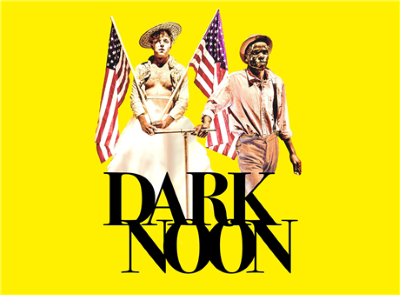THE NOT-SO-GOOD, THE BAD
AND THE REALLY REALLY UGLY
What better way to get a fresh perspective of our American West than by attending a 300-year history reenactment in 100 minutes? Written and directed by the acclaimed Danish director Tue Biering, with Nhlanhla Mahlangu as his co-director and choreographer, and performed by seven South African actors, the take from these outsiders on U.S. history is startling, despicable, and ultra-violent. In other words, more accurate than not. It’s no surprise that the sprawling, striking, immersive and multi-faceted Dark Noon — which opened tonight at St. Ann’s Warehouse — has toured all over Europe, including the Edinburgh Festival Fringe.
Lillian Tshabalala-Malulyck
Thulani Zwane
Performed without intermission in the style of a Hollywood western, there are laughs throughout, which allows us to review our history with fresh eyes, release tension, and survive the body blows that are hurled our way. It’s jaw-droppingly audacious, and breathtakingly fearless, daring you to either look away or challenge what you’re seeing. This not-to-be-missed performance offers the rare glimpse of brilliantly theatrical chaos, a perfect reminder of our own tumultuous dark times. Attending is also an ideal way to celebrate Independence Day.
Thulani Zwane
The play is divided into nine chapters, beginning with “Go West” during which white, sickly Europeans make the journey overseas to America where “people shot at each other for no apparent reason … a time where white lives didn’t matter.” The chapters that follow are to be expected, each a formative scene from North America’s history. One has European pioneers racing to suck up territory in “Owning the Land,” or rather “My Land’”LEAVE!” It is shocking and humbling to be reminded — even through humor — of cannibalism, rape, and the murders of Indigenous people. The battle genocide of Natives is shown through a reenactment of a football game, “Settlers vs. Natives”. Even when a Native scores a touchdown and wins the game, the brownskin is shot dead with a gun. And after collapsing unconscious, he stands only to be shot again. He stands. Shot. He stands. Shot. By the sixth and seventh time, you’re not laughing, and the history lesson is complete.
More chapters follow: “A Little House on the Prairie,” “Gold Gold Gold,” “A Primitive Civilization,” “The Love of God,” “The Law of the Jungle,” all the way to 1890, which marks the end of the Wild Wild West as we know it.
Lillian Tshabalala-Malulyck, audience participants, and the cast
Siyambonga Alfred Mdubeki, Joe Young, the cast, and audience participants
You may be pulled onstage to participate as a church congregation when the preacher asks for all the money in your pockets; as customers in the merchant store — none of whom have money to buy anything; as clients of the bank when it’s robbed — “pick up the bills from the floor.” Yes, it’s funny, but there’s a dark side that ultimately slaps you in the face and kicks you in the gut. When three white audience members with a black smear of makeup applied to their forehead are auctioned as slaves, black actors in blond wigs and white powder on their faces try to outbid each other for the merchandise. My stomach caved in and knotted.
Siyambonga Alfred Mdubeki
Each actor plays a multitude of characters, moves scenery, operates cameras, instructs audience members — it’s a tour de force for The Magnificent Seven: Mandla Gaduka, Katlego Kaygee Letsholonyana, Bongani Bennedict Masango, Siyambonga Alfred Mdubeki, Lillian Tshabalala-Malulyck, Joe Young and Thulani Zwane.
Siyambonga Alfred Mdubeki
The audience is seated on three-sides of a bare stage, but Johan Kølkjær’s setting won’t remain empty for long. Representing America, the sets are gradually built upon a dirty tarp as the performance progresses. A church will be constructed, as well as a merchant store, a bank, a politician’s office, a pioneer home, a Chinese restaurant, a bar and whorehouse, a jail, and an outdoor holding pen. Oh, and a railroad track runs down the center of the stage ending at the mines. Plus, the endless props by Marie Rosendahl Chemnitz, cameras displaying live filming of scenes as they take place (video designer Rasmus Kreiner), and microphones (sound designer Ditlev Brinth). By the end, there’s so much scenery that other spectators disappear from view. Stage Manager Svante Huniche Corell and his crew notably uphold the challenging staging, allowing the pandemonium to unfold with perfection.
Katlego Kaygee Letsholonyana and Bongani Bennedict Masango
Katlego Kaygee Letsholonyana, audience participants, and the cast
After the last lesson is offered, there’s an epilogue. Each actor appears on camera and speaks candidly about their upbringing in South Africa and their introduction to Hollywood Western films. “Guns were romanticized. We would reenact shooting each other with tree logs”; “Many people in my township died by the gun and I blame westerns for romanticizing it so much”; “This world is full of gangsters. Capitalism. Colonialism. The world is run by gangsters”; “I look back and wonder if it was really healthy for me as a young black man to be exposed to that kind of violence.” The final lesson emerges: Hollywood Westerns are not simply an entertainment but rather a cinematic genre perpetrating guns and violence, teaching children internationally to shoot and murder. And above all, when a white-faced supposed hero comes along, you’d best take heed, pardner, before it comes after you.
Katlego Kaygee Letsholonyana
photos by Teddy Wolff courtesy of St. Ann’s Warehouse
Dark Noon
FIX+FOXY
St. Ann’s Warehouse, 45 Water St in Brooklyn (on the waterfront in Brooklyn Bridge Park)
100 minutes, no interval
ends on July 7, 2024
for tickets, visit St. Anne’s Warehouse
find Gregory Fletcher at website, Facebook, and Instagram

